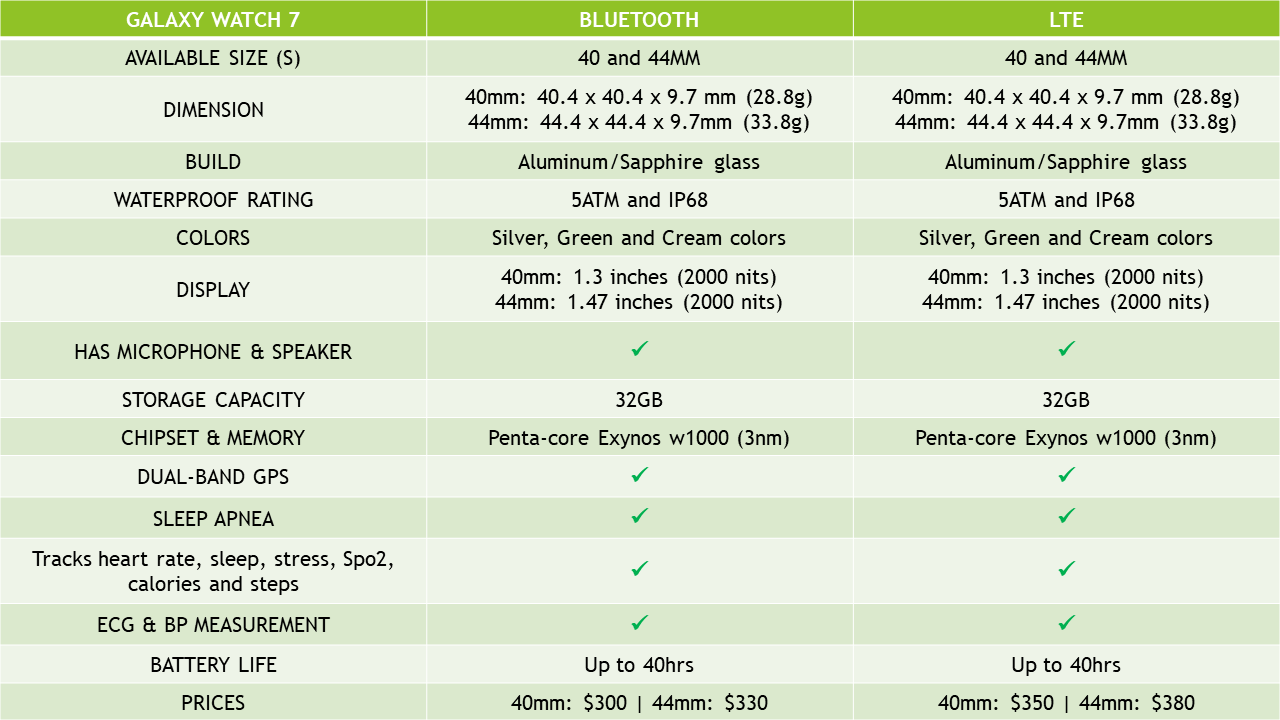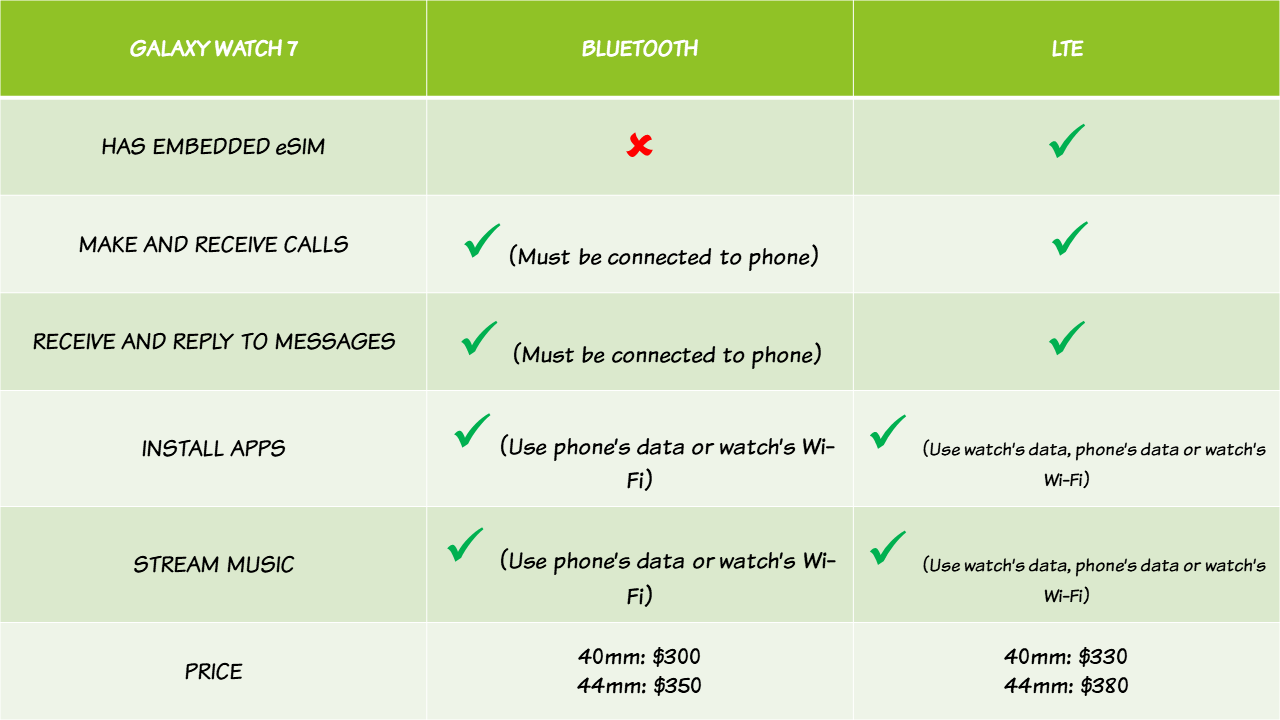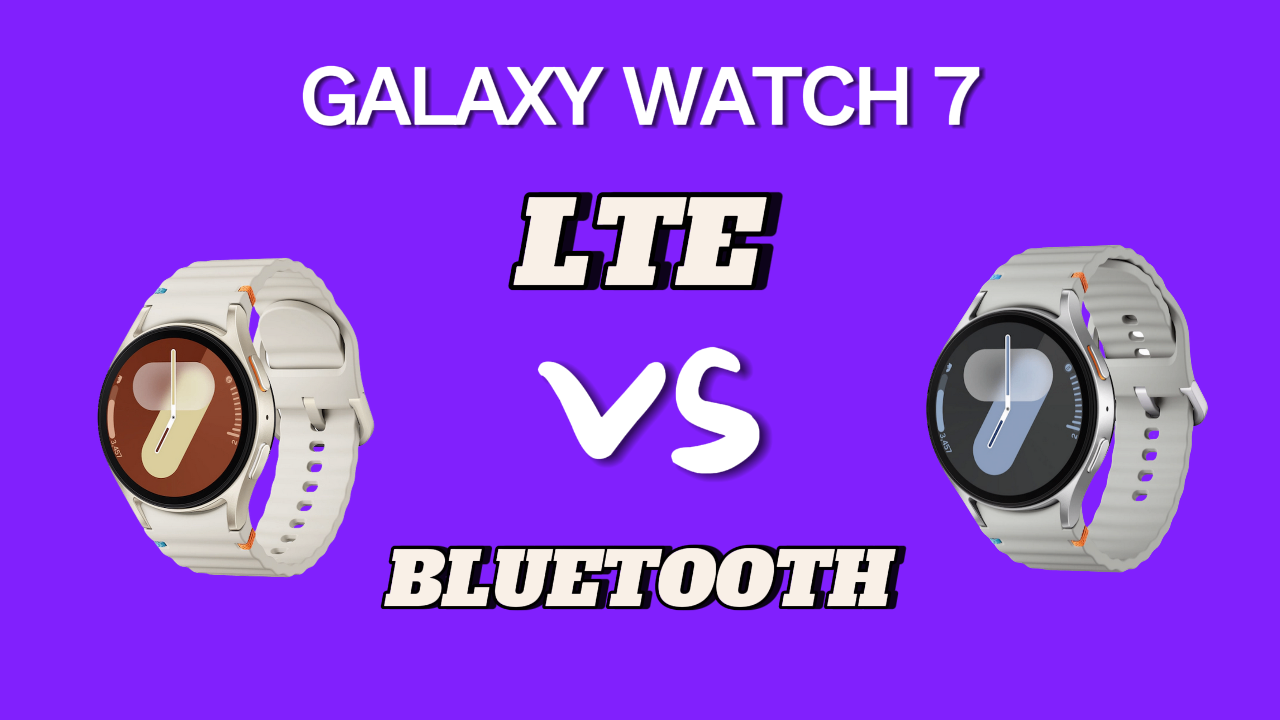It is official! Samsung has announced the Galaxy Watch 7 alongside the Galaxy Watch Ultra. Pre-orders for both watches have started and shipment will commence from 24th July. The new Galaxy Watch 7 which succeeds the Galaxy Watch 6 is powered by a more advanced Exynos W1000 chip and has a higher 32GB of storage. It also welcomes an improved Bioactive sensor that improves activity tracking accuracy. Moreover, it has dual-band GPS for increased location tracking accuracy.
Like the Galaxy Watch 6, the Galaxy Watch 7 comes in 40 and 44mm sizes and each of these is available in Bluetooth and LTE models. In this post, I will be telling you the difference between Bluetooth and LTE, perhaps I can help you decide which model is right for you.
Galaxy Watch 6 vs 7: What is New?

But before that, let’s take a look at what’s new to the Galaxy Watch 7.
- Galaxy Watch 7 has an improved processor
- Galaxy Watch 7 has a bigger storage
- Galaxy Watch 7 has improved sensors and features for Sleep apnea
- Galaxy Watch 7 and Ultra Welcome Galaxy AI
- Galaxy Watch 7 features dual-band GPS
The Galaxy Watch 7 is equipped with a faster processor. It comes with a 5-core Exynos W1000 chip which is based on a 3nm fabrication process. Samsung claims the new chip can launch apps 2.7x faster than the W930 chip in Galaxy Watch 6.
In addition to the new processor, Samsung has also bumped up the storage capacity of the Galaxy Watch 7. It comes with 32GB of storage which is twice that of Galaxy Watch 6. It joins the likes of Pixel Watch 2 which also has 32GB storage but still falls behind the 64GB of Apple Watch Series 9. With a bigger 32GB of storage, you will have around 24GB for music and app downloads.
The sensors of the Galaxy Watch 7 have also received significant upgrades. It comes with an improved Bioactive sensor which boasts 3x more LED light and will ensure increased tracking accuracy. Sleep apnea has also been added to the Galaxy Watch 7 and Ultra, though this feature will come to Galaxy Watch 4, 5, 6, and FE.
Samsung has also introduced Galaxy AI to the Galaxy Watch 6 and 7. It is expected to help give you an Energy score based on your sleep and heart rate data. Galaxy AI will also make replying to messages effortless. Interestingly, the Energy score will also come to older Galaxy Watches.
Finally, the Galaxy Watch 7 and Ultra welcome dual-band GPS support. These two are the first Galaxy Watches to have multi-band GPS – a feature that has been on many Garmin watches and Apple Watch Ultra 2.
With dual-band GPS, the Galaxy Watch 7 will be able to use both L1 and L5 signals to accurately track your location and pace even in difficult terrains with tall buildings or trees.
Galaxy Watch 7 LTE vs Bluetooth – Key Difference

Now that you know what’s new to the Galaxy Watch 7, let’s take a look at the differences between the two models.
- The LTE model has an electronic SIM (it is a standalone watch
- Prices
In a few words, the LTE and Bluetooth models are the same in every aspect except that the LTE model has an embedded eSIM that enables cellular connectivity just like you have it on phones.
Because of the cellular capabilities of the LTE model, it can make and receive calls without connecting to your phone. It can also receive and reply to messages without connecting to your phone.
That’s to say that with the LTE model, you don’t need to carry your phone along to be able to make and receive calls on the watch.
On the other hand, the Bluetooth model also has a speaker and microphone that enables on-wrist calls. However, unlike the LTE model, it must be connected to your phone to be able to make and receive calls. It also needs to be connected to your phone to receive and reply to SMS messages.
Meanwhile, both watches have Wi-Fi, and with that, you don’t need your phone to stream or download music. You can also use the watch’s Wi-Fi to install and access your favorite apps like WhatsApp, Gmail, Google Maps, Spotify and YouTube Music.
Beyond the cellular capabilities of the cellular model, both watches have the same armor aluminum build. The same sAMOLED display with up to 2000nits in brightness. Both watches also have the same 32GB of storage and the same health tracking features.
The battery life of both models is also the same at up to 40 hours. Though, logically, when LTE is activated, the LTE model will have a shorter battery life. To get a longer battery life, you can turn off LTE when you are with your phone.

As a result of the standalone capabilities of the LTE model, it is priced a little higher. It costs $50 more than the Bluetooth model. While the 40 and 44mm unit Bluetooth models retail for $300 and $330 respectively, the LTE 40 and 44mm unit have $350 and $380 price tags respectively.
Before You Buy The LTE Model

Before you decide to get the LTE model, it is important to understand how it works. The LTE model uses what is called Number share which will allow the watch to have its number but will be linked to your current phone number. This means that when you are away from your phone and there is a call to your current phone number, that call will be rerouted to the watch. This means that you don’t even need to give out the watch’s number.
Because the watch has to be linked to your current phone number, both phone and watch must be on the same network. This means if you’re currently using US Cellular, the watch will also be on the same US cellular network.
So before you get the LTE model, inquire from your current service provider if they offer plans for the Galaxy Watch 7 LTE. In the US, supported carriers include, AT&T, T-Mobile, US Cellular and Verizon.
You should also know that carriers will charge a monthly fee for data plans on the watch, this is around $10 in the US.
LTE or Bluetooth? Which Should You Buy?
So, should you get the LTE model?
Before deciding to get the LTE model you need to factor in not just the extra $50 but also the recurring monthly fee for data on the watch. If you are okay with that then it’s okay.
Reasons to Get the LTE model
- Get the LTE model if you are always away from your phone but still want to receive incoming calls and SMS messages.
- Get the LTE model if you do a lot of outdoor workouts. You never can tell, a fall might happen and you can’t reach your phone, in this case, the fall detection feature can be a lifesaver.
Or say while working out, your phone runs down. Or perhaps, like me, you hate carrying your phone along during a workout. Whatever the case may be, the LTE model will help you stay connected when your phone is inaccessible.
- Finally, I always recommend the LTE model for seniors. It can be a lifesaver when a fall occurs or you are too tired to get the phone.
So clearly, the LTE offers more freedom from your phone than the Bluetooth model. But then the Bluetooth model is always a popular choice because it is cheaper.
You can also watch this comparison on my YouTube video.

